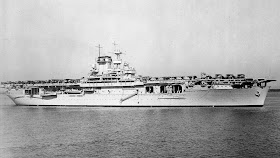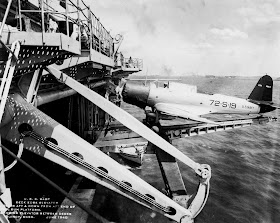Beginning in 1942, Allied intelligence began a systematic analysis of the Fiesler Fi 103 flying bomb better known as the V-1. Analysis of crashed test articles combined with photoreconnaissance and intelligence collected by agents within occupied Europe led the United States in particular to restart its flying bomb programs in 1943 that had laid dormant for the most of the Second World War on account of what was felt to be beyond the current state of the art. In 1944, Northrop was contracted to begin development of the first US flying bomb, designated the JB-1. Running parallel to the Northrop effort was the reverse-engineering of the V-1 using 2,500 lbs of salvaged V-1 parts that had been provided by Great Britain. The parts arrived at Wright-Patterson Field in Dayton, Ohio, on 13 July 1944 and the US Army Air Forces directed the engineering staff there to build 13 copies of the V-1. Quite remarkably, the USAAF technical staff completed the first copy in just three weeks! To put the scope of the success of the Allied intelligence effort and the work the Wright-Patterson Field team into perspective, the first German V-1s struck Britain on 12-13 June 1944. By the end of the following month, the USAAF had its first copy of the V-1 and they had test fired the reverse-engineered pulse jet engine. A memo from the technical team responsible to General Henry Arnold, head of the USAAF, recommended mass production at the earliest opportunity- however, General Arnold and his advisors were well aware of the V-1's inaccuracy and despite reservations that production of an American V-1 would divert crucial wartime resources and manpower from battle-proven weapons, it was felt that if the guidance of the V-1 could be improved, an American version might be useful.
 |
The Republic-Ford JB-2 differed from the V-1 in minor details
(USAF/Wikipedia) |
Republic Aviation was tasked with producing the American V-1 which was designated JB-2 with the first of the thirteen USAAF copies arriving on 8 September 1944 from Wright-Patterson Field. The USAAF ordered 1,000 JB-2s from Republic. The Ford Motor Company was tasked with producing the JB-2's pulse jet engine which was designated the PJ31. With Republic's resources nearly all committed to the production of the P-47 Thunderbolt, the company subcontracted the airframe assembly to Willys-Overland, the same company that built the Jeep. With Ford responsible for engine production, the Jack & Heintz Company of Cleveland which had been building aircraft electrical components and autopilots as a subcontractor was given responsibility for the JB-2's control system. Alloy Products of Wisconsin was given responsibility for the fuel tanks and pressure vessels used in the JB-2 while the Northrop was contracted for the JB-2's launch sled. The booster rockets that actually propelled the JB-2 off the ground were contracted to Monsanto.
By the end of September 1944, the USAAF revised its initial order for 1,000 JB-2s to 1,000 JB-2s *per* month with a target goal to reach that rate by April 1945. The first JB-2 launch took place at Eglin Airfield in Florida on 12 October 1944- just three months had elapsed since start of the German V-1 campaign against London and the first American copy had made its first flight! Flight testing was also carried out at Wendover Field in Utah at the same time that the B-29 Superfortress unit that dropped the atomic bombs, the 509th Composite Group, was a tenant at Wendover training for their special mission. The flight tests didn't go too smoothy- by the first week of December, there were two successful flights out of ten launches.
 |
JB-2 air launch from a B-17 at Eglin Army Air Field in 1944
(USAF/Wikipedia) |
Northrop's own flying bomb design, the JB-1, made its first launch in December 1944 but crashed after launch. (The JB-1 will be the subject of its own later article here at Tails Through Time.) With the the early failures of the JB-1 and problems with its jet powerplant, the USAAF decided to continue with the development of the Northrop design but production and operational priority went to the JB-2. Despite issues with accuracy in the flight tests at Eglin and Wendover, the USAAF leadership pushed for an increased production rate for the JB-2 to at least 3,000 per month. On 14 January 1945, General Arnold ordered another 75,000 JB-2s with the ability to launch 100 per day by September and 500 per day by January 1946 in anticipate of the invasion of Japan. On the next day, the JB-2 program got the same priority that was given to the B-29 Superfortress program.
Despite the enthusiasm from the USAAF leadership, theater and operational commanders were skeptical of the JB-2. The generally poor European weather that was interfering with the strategic bombing campaign, however, offered perhaps some utility for the JB-2 as it wasn't dependent on clear weather- a view supported by Sir Trafford Leigh-Mallory, the head of the Royal Air Force and commander-in-chief of Allied air forces for the Normandy invasion as well as General Carl Spaatz, head of US Strategic Air Forces Europe. Spaatz, however, was a bit more measured in his support for the employment of the JB-2. He felt that it was more a harassment weapon that could be used when bad weather precluded a strategic bombing mission and outlined his planned use at 300 JB-2s per day only 10 days out of the month. But General Spaatz was very specific that operational employment of the JB-2 could not interfere with heavy bomber operations and he personally expressed concerns to General Arnold regarding the JB-2's cost-effectiveness given its inaccuracy.
The JB-2 flight test program centered primarily on improving the weapon's accuracy. The first successful flights in the fall of 1944 showed an average error of eight miles at a range of just over 120 miles, not much better than what the Germans were averaging in their own V-1 campaign. The next step by the USAAF was to install radio guidance control in the JB-2. Using a radar beacon and remote control, it was thought the JB-2's accuracy could be improved. However, continued flight tests showed in 20 flight tests with the new guidance system, the JB-2's average error was no better than it was before with preset controls. Things did get better though- by war's end, the JB-2 with preset controls was averaging 5 miles error over a range of 150 miles and 1/4 mile error over a range of 100 miles with radio guidance.
The biggest stumbling block to the operational deployment of the JB-2 in Europe in 1945, believe it or not, was logistical. The sheer numbers of JB-2s needed competed with other munitions production and it was estimated by some in the War Department that just transporting the JB-2 and its associated equipment to Europe would take up nearly 25% of Allied shipping capacity in the Atlantic. Brief consideration was given to moving JB-2 production to Europe, but there simply wasn't the production capacity anywhere else but the United States to produce the numbers of JB-2s planners envisioned using.
With the end of the war in Europe, JB-2 production numbers remained in flux as planners debated what was needed for the planned invasion of Japan. By this point, however, the production and logistical concerns for the mass deployment of the JB-2 had exhausted the initial enthusiasm for the weapon. Production was halted initially at the end of January 1945 but then reinstated at a lower rate. By the time of the Japanese surrender, 1,385 JB-2s had been built when production was terminated.
Concurrent with the USAAF testing, the US Navy worked on a navalized version of the JB-2 that would have been launched from specially-modified LSTs and escort carriers during the invasion of Japan. Fifty-one JB-2s were requested by the Navy for its own testing program in September 1944 when production was launched. While airborne launches from B-17 Flying Fortresses were done during testing at Eglin Field, the Navy planned to launch JB-2s from Consolidated PB4Y Privateers as well. Navy planners, however, didn't expect operational capability with the JB-2 (which was called the Loon by the Navy) until August or September 1946. The first Navy Loon launch was on 7 January 1946 with the Secretary of the Navy approving the conversion of two submarines for Loon operations in March 1946. Conversion of the USS Cusk (SS-348) began in January 1947. The Cusk entered the history books on 18 February 1947 as the world's first missile submarine when it made its first Loon launch...which ended in failure after only 3.5 miles of flight. The Cusk finally had its first successful launch on 7 March 1947 after five tries. Submarine launch had become the Navy's focus for the Loon program with the USS Carbonero (SS-337) also modified for the program and by 1949 finally carried out a firing from a surface ship, the test ship USS Norton Sound. In March 1950, the Navy terminated in the Loon in favor of the more promising Regulus cruise missile.
 |
The USS Cusk fires a JB-2 Loon
(US Navy/Wikipedia) |
With the US Air Force becoming independent in 1947, the JB-2 program was reactivated in March 1948 at Holloman AFB in New Mexico as part of a program for the development of missile guidance systems and seeker technology. Work using the JB-2 benefitted the later Matador cruise missile program with the JB-2 program winding down by 1949 with test airframes successfully being flown remotely and skid landed for recovery. A joint effort with Eglin AFB also used the JB-2 as a target drone for the development of gunsights. Interestingly "Flakzielgerät 76" was the German cover name for the V-1 during its development which loosely translates as anti-aircraft target device.
Further reading:
British Defenses Against the Summer 1944 V-1 Bombardment
Regulus: The US Navy's First Operational Nuclear Missile
CHECK SIX: Ships Damaged or Sunk by the Yokosuka MXY7 Ohka
Sources: The Evolution of the Cruise Missile: Comprehensive History from the V-1 and V-2 to the Tomahawk and Snark by Kenneth P. Werrell. Air University Press/USAF, 1983, pp 79-85. V-1 Flying Bomb 1942-1952: Hitler's Infamous Doodlebug (New Vanguard No. 106) by Steven J. Zaloga. Osprey Publishing, 2005, pp 39-41.





























